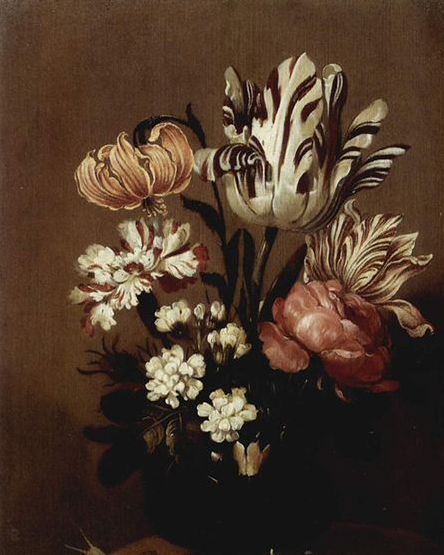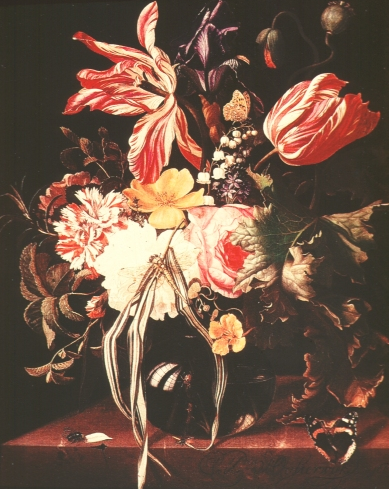Still life paintings were common in Netherlands in 17th century. Artists made these paintings with specific intentions and objectives. Dutch people have loved flowers since time in memorial. Artist took an initiative to represent various flowers in paintings. Flowers were in a sub-genre of still life which was highly regarded and well paid in Middleburg, Amsterdam and Utrecht cities in Netherlands. This encouraged them to make aesthetically attractive paintings.
According to Haak and Willems-Treeman (1984), artists depicted flowers in impossible arrangements to strengthen attraction to people who viewed them. The main reason for making these depictions in Amsterdam and other Dutch cities was to provide a cheaper way of having flowers in people’s homes.
The Dutch valued flowers so much and only the rich could afford banquets. Ordinary people were forced to buy depictions rather than real ones. Artists painted the pictures to look as real as possible. Various flowers were meant to represent certain believe held by residence of Dutch republic. Some flowers represented religious believes while others represented feelings.
We are all expected to make judgments on these pictures. Like other sub-genres of still life paintings, flower depictions had moralistic messages. However, some messages would not stand the test of time. Most of the paintings were for religious purposes. For example, the Madonna lily was used to represent Virgin Mary because of its unique features.
The white iris represented Virgin Mary’s purity, while the rose was a sign of her love. We can as well judge the artists for just depicting what was expected of them by people instead of expanding their own ideas (Haak & Willems-Treeman, 1984).
The judgments are epistemological since depictions occurred and they represented flowers from different seasons in ancient Dutch. More so, they represented existing flowers which were grown in gardens or banquets in vases. Some depictions were combination of flowers from different seasons painted on one surface.
The pictures of flowers depicted on surfaces were appealing to people who bought them. They were considered a substitute of real flowers for people who did not afford banquets. Some artist did them on tableware which was found to be appealing by customers. However, some flowers were depicted from species seen in foreign places and people could not relate them to anything until later. Tulip was brought from Asia; however, it was not popular until later in 17th century.
Most flowers represented class while others represented religious believes. Sunflower was believed to represent the love of God yet in modern days it is used to manufacture food products (Haak & Willems-Treeman, 1984). The image of flowers shows us that the Dutch have loved flowers since time in memorial. This is reflected by the current per capita consumption of commercial flowers which rank Netherlands at the top.
Because of flourishing painting business, depictions from Dutch republic were sold to countries in South America and Indies. Later on, other countries around the world bought the pictures too. This increased demand for flowers which were cherished by Dutch in other countries. This contributed to the current demand of flowers all over the world.
Still life paintings in Netherlands varied and included breakfast pieces, flowers, flowers and fruits, vanitas paintings, curtain paintings, pronk and Trompe L’Oeil. Still life paintings came up because of flourishing trade and introduction of exotica. The first still life paintings in 17th century were flowers encouraged by introduction of tulip from foreign countries.
It then included flowers with fruits, breakfast piece and then banquet piece which was influenced by increased wealth among people. Influence of calvins led to vanitas paintings in the mid 17th century. Trompe L’Oeil emerged after vanitas as a result of the Dutch’s need for humor. Trompe L’Oeil is a French phrase which meant ‘deceive the eye’ and it blended well with the Dutch’s needs.
Towards the end of the 17th century, tastes of consumers changed which led to emergence of pronk sub-genre. This represented the beginning of ostentatious. The pronk sub-genre was as a result of change in colour taste which in turn led to more baroque artistic paintings ((Haak & Willems-Treeman, 1984).
Jan Davidsz de Heem was a known painter of flowers in Netherlands. His work has stood the test of time. He combined fruits, lobsters, butterflies, moths and flowers in his paintings. He also drew several vases of flowers in his time. His work improved gradually as the time went by. His 1640 chased tankard had several elements on a marble table.
They included lemon, bottle and a silver cup. His 1648 masterpiece comprised of grapes, flowers and wheat sheaves which showed that he had mastered the art of painting by the time. The painting is in Belvedere Vienna. In 1650, Jan Davidsz de Heem proved that he could harmonize bright colors on a large scale painting than before.
The difference in the 1640 chased tankard painting and the 1650 Madonna masterpiece shows clearly that there is a big difference in aesthetic. Jan Davidsz de Heem improved his artistic skills gradually to reach the standard he was when he painted the Madonna (Haak, 1978).
Works Cited
Haak, Bob., & Willems-Treeman Elizabeth. The Golden Age: Dutch painters of the seventeenth century. New York: H.N. Abrams, 1984. Print
Haak, Bob. The Golden Age: Dutch Painters of the Seventeenth-Century: Part I, Still Lives. New York, 1978. Print.
Appendix 1

Vase of flowers painted by Dutch artist
Appendix 2

Vase of tulip with insects. Painted by Jan Davidsz de Heem